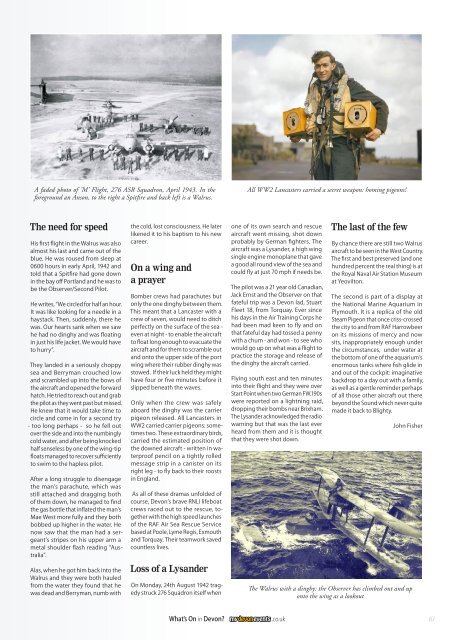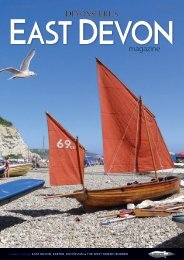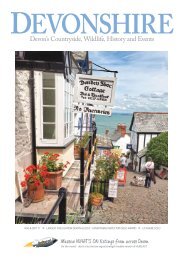Devonshire June July 16
Everything Devon: Countryside, Wildlife, History, Events, Music
Everything Devon: Countryside, Wildlife, History, Events, Music
Create successful ePaper yourself
Turn your PDF publications into a flip-book with our unique Google optimized e-Paper software.
A faded photo of ’M’ Flight, 276 ASR Squadron, April 1943. In the<br />
foreground an Anson, to the right a Spitfi re and back left is a Walrus.<br />
All WW2 Lancasters carried a secret weapon: homing pigeons!<br />
The need for speed<br />
His first flight in the Walrus was also<br />
almost his last and came out of the<br />
blue. He was roused from sleep at<br />
0600 hours in early April, 1942 and<br />
told that a Spitfire had gone down<br />
in the bay off Portland and he was to<br />
be the Observer/Second Pilot.<br />
He writes, “We circled for half an hour.<br />
It was like looking for a needle in a<br />
haystack. Then, suddenly, there he<br />
was. Our hearts sank when we saw<br />
he had no dinghy and was floating<br />
in just his life jacket. We would have<br />
to hurry”.<br />
They landed in a seriously choppy<br />
sea and Berryman crouched low<br />
and scrambled up into the bows of<br />
the aircraft and opened the forward<br />
hatch. He tried to reach out and grab<br />
the pilot as they went past but missed.<br />
He knew that it would take time to<br />
circle and come in for a second try<br />
- too long perhaps - so he fell out<br />
over the side and into the numbingly<br />
cold water, and after being knocked<br />
half senseless by one of the wing-tip<br />
floats managed to recover sufficiently<br />
to swim to the hapless pilot.<br />
After a long struggle to disengage<br />
the man’s parachute, which was<br />
still attached and dragging both<br />
of them down, he managed to find<br />
the gas bottle that inflated the man’s<br />
Mae West more fully and they both<br />
bobbed up higher in the water. He<br />
now saw that the man had a sergeant’s<br />
stripes on his upper arm a<br />
metal shoulder flash reading “Australia”.<br />
Alas, when he got him back into the<br />
Walrus and they were both hauled<br />
from the water they found that he<br />
was dead and Berryman, numb with<br />
the cold, lost consciousness. He later<br />
likened it to his baptism to his new<br />
career.<br />
On a wing and<br />
a prayer<br />
Bomber crews had parachutes but<br />
only the one dinghy between them.<br />
This meant that a Lancaster with a<br />
crew of seven, would need to ditch<br />
perfectly on the surface of the sea -<br />
even at night - to enable the aircraft<br />
to float long enough to evacuate the<br />
aircraft and for them to scramble out<br />
and onto the upper side of the port<br />
wing where their rubber dinghy was<br />
stowed. If their luck held they might<br />
have four or five minutes before it<br />
slipped beneath the waves.<br />
Only when the crew was safely<br />
aboard the dinghy was the carrier<br />
pigeon released. All Lancasters in<br />
WW2 carried carrier pigeons: sometimes<br />
two. These extraordinary birds,<br />
carried the estimated position of<br />
the downed aircraft - written in waterproof<br />
pencil on a tightly rolled<br />
message strip in a canister on its<br />
right leg - to fly back to their roosts<br />
in England.<br />
As all of these dramas unfolded of<br />
course, Devon’s brave RNLI lifeboat<br />
crews raced out to the rescue, together<br />
with the high speed launches<br />
of the RAF Air Sea Rescue Service<br />
based at Poole, Lyme Regis, Exmouth<br />
and Torquay. Their teamwork saved<br />
countless lives.<br />
Loss of a Lysander<br />
On Monday, 24th August 1942 tragedy<br />
struck 276 Squadron itself when<br />
one of its own search and rescue<br />
aircraft went missing, shot down<br />
probably by German fighters. The<br />
aircraft was a Lysander, a high wing<br />
single engine monoplane that gave<br />
a good all round view of the sea and<br />
could fly at just 70 mph if needs be.<br />
The pilot was a 21 year old Canadian,<br />
Jack Ernst and the Observer on that<br />
fateful trip was a Devon lad, Stuart<br />
Fleet 18, from Torquay. Ever since<br />
his days in the Air Training Corps he<br />
had been mad keen to fly and on<br />
that fateful day had tossed a penny<br />
with a chum - and won - to see who<br />
would go up on what was a flight to<br />
practice the storage and release of<br />
the dinghy the aircraft carried.<br />
Flying south east and ten minutes<br />
into their flight and they were over<br />
Start Point when two German FW.190s<br />
were reported on a lightning raid,<br />
dropping their bombs near Brixham.<br />
The Lysander acknowledged the radio<br />
warning but that was the last ever<br />
heard from them and it is thought<br />
that they were shot down.<br />
The last of the few<br />
By chance there are still two Walrus<br />
aircraft to be seen in the West Country.<br />
The first and best preserved (and one<br />
hundred percent the real thing) is at<br />
the Royal Naval Air Station Museum<br />
at Yeovilton.<br />
The second is part of a display at<br />
the National Marine Aquarium in<br />
Plymouth. It is a replica of the old<br />
Steam Pigeon that once criss-crossed<br />
the city to and from RAF Harrowbeer<br />
on its missions of mercy and now<br />
sits, inappropriately enough under<br />
the circumstances, under water at<br />
the bottom of one of the aquarium’s<br />
enormous tanks where fish glide in<br />
and out of the cockpit: imaginative<br />
backdrop to a day out with a family,<br />
as well as a gentle reminder perhaps<br />
of all those other aircraft out there<br />
beyond the Sound which never quite<br />
made it back to Blighty.<br />
John Fisher<br />
The Walrus with a dinghy: the Observer has climbed out and up<br />
onto the wing as a lookout<br />
in mydevonevents..co.uk 87


















